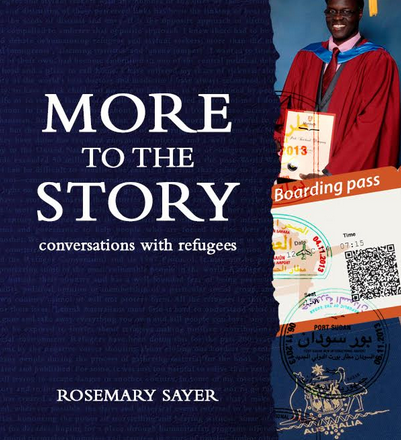
More to the Story: Conversations with Refugees
Rosemary Sayer
Margaret River Press
As the major political parties in Australia shifted into election mode earlier this year, the topic of refugees was almost always one that elicited an emotional response, with questions like ‘who are these people?’, ‘why did they come here?’ and ‘why should we care about them?’ becoming the norm. The recent release of over 2,000 confidential files on the Nauru detention centre that exposes sexual assault, child abuse and inhuman detention practices has seen a surge of interest in the public wanting more information and transparency around asylum seekers held in detention.
More to the Story: Conversations with Refugees by Rosemary Sayer is an important collection of stories told by individuals who came to Australia seeking refuge, and provides personal insight into the questions so often raised within political forums, which arguably drowns out the voices that matter most in the mainstream debates about refugees.
The 1951 Convention and Protocol Relating to the Status of Refugees, of which Australia is a signatory, states that a person is a refugee if they are outside of their country due to fear and likelihood of prosecution due to their religion, race, nationality, political opinion or member of a social group (often a minority group).
More to the Story: Conversations with Refugees is a vital contribution to understanding the complex tapestry of the human experience that refugees bring with them when they embark on their journeys and settle in their new countries.
As an expat living overseas, Sayer notes that she was regularly asked why Australians were racist towards refugees, with Chinese friends concerned with the rise of Pauline Hanson’s One Nation Party and the anti-immigrant sentiment playing out in the media. Sayer writes that the reason she became interested in presenting the unique stories of refugees was because she “felt compelled to embrace the opposite approach” of how refugees’ stories are commonly represented and politicised, in order to provide a voice to those who are regularly silenced by states, governments and the media.
More to the Story: Conversations with Refugees is a vital contribution to understanding the complex tapestry of the human experience that refugees bring with them when they embark on their journeys and settle in their new countries. The stories feature diverse characters from disparate countries, from Naw Pi, a Karen from Myanmar who fled from persecution by the Burmese military who raided her village to Abdul Farid Sufizada, one of the 428 people on board the Tampa, the ship that became a turning point in Australian politics around the management of refugees and asylum seekers.
Sayers reflects that “spending time among refugee families that had often been dislocated by war and were now living such challenging lives had constantly made [her] reflect on [her] family’s good fortune of being born in Australia”.
Interestingly, Sayer includes a chapter on those who have been left behind – illustrating that the journey to becoming a refugee is often not taken in isolation and that there are far-reaching consequences that are often unseen. Sayers explores how familial ties are often strengthened when a husband, brother, mother or sister flees in the hope of a better life.
The author also visits Mae La, the biggest refugee camp on the border of Thailand and Myanmar, and attempts to document the entire experience of the refugees there with sensitivity. At Mae La, Sayers notes that “the significant effort made by all the refugees to maintain their dignity and hope in the camp community” contributed to their ability to maintain a positive outlook, despite some of them being there for numerous years while their claims were being assessed.
In the process of writing More to the Story: Conversations with Refugees, Sayers often had her own cultural constructs and ideas about refugees and the circumstances leading to them seeking asylum challenged. In her introduction, Sayers notes that she rarely harboured a thought as to what it meant to live in a free society until she spoke intimately with the refugees who had themselves become displaced because of socio-political interference.
More to the Story: Conversations with Refugees expertly weaves together not only conversations with refugees but the historical and socio-political backdrops that have forced them to flee their countries for shelter in Australia. As Australia’s treatment of refugees and asylum seekers increasingly becomes a political and moral issue, it is well worth reading this book to hear authentic voices.

